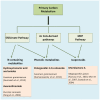Metabolomics of cereals under biotic stress: current knowledge and techniques
- PMID: 23630531
- PMCID: PMC3632780
- DOI: 10.3389/fpls.2013.00082
Metabolomics of cereals under biotic stress: current knowledge and techniques
Abstract
Prone to attacks by pathogens and pests, plants employ intricate chemical defense mechanisms consisting of metabolic adaptations. However, many plant attackers are manipulating the host metabolism to counteract defense responses and to induce favorable nutritional conditions. Advances in analytical chemistry have allowed the generation of extensive metabolic profiles during plant-pathogen and pest interactions. Thereby, metabolic processes were found to be highly specific for given tissues, species, and plant-pathogen/pest interactions. The clusters of identified compounds not only serve as base in the quest of novel defense compounds, but also as markers for the characterization of the plants' defensive state. The latter is especially useful in agronomic applications where meaningful markers are essential for crop protection. Cereals such as maize make use of their metabolic arsenal during both local and systemic defense responses, and the chemical response is highly adapted to specific attackers. Here, we summarize highlights and recent findings of metabolic patterns of cereals under pathogen and pest attack.
Keywords: chemical analytical techniques; chemical defense; metabolic profile; monocots; phytoalexins; secondary metabolites.
Figures



Similar articles
-
Plant Defense Responses to Biotic Stress and Its Interplay With Fluctuating Dark/Light Conditions.Front Plant Sci. 2021 Mar 4;12:631810. doi: 10.3389/fpls.2021.631810. eCollection 2021. Front Plant Sci. 2021. PMID: 33763093 Free PMC article. Review.
-
Proteomics and Metabolomics Studies on the Biotic Stress Responses of Rice: an Update.Rice (N Y). 2021 Mar 15;14(1):30. doi: 10.1186/s12284-021-00461-4. Rice (N Y). 2021. PMID: 33721115 Free PMC article. Review.
-
Metabolomics by UHPLC-HRMS reveals the impact of heat stress on pathogen-elicited immunity in maize.Metabolomics. 2021 Jan 5;17(1):6. doi: 10.1007/s11306-020-01739-2. Metabolomics. 2021. PMID: 33400019
-
Saponins, the Unexplored Secondary Metabolites in Plant Defense: Opportunities in Integrated Pest Management.Plants (Basel). 2025 Mar 10;14(6):861. doi: 10.3390/plants14060861. Plants (Basel). 2025. PMID: 40265787 Free PMC article. Review.
-
Phytobiome metabolism: beneficial soil microbes steer crop plants' secondary metabolism.Pest Manag Sci. 2019 Sep;75(9):2378-2384. doi: 10.1002/ps.5440. Epub 2019 May 13. Pest Manag Sci. 2019. PMID: 30973666 Review.
Cited by
-
Comprehensive and Comparative Metabolomic Profiling of Wheat, Barley, Oat and Rye Using Gas Chromatography-Mass Spectrometry and Advanced Chemometrics.Foods. 2014 Oct 31;3(4):569-585. doi: 10.3390/foods3040569. Foods. 2014. PMID: 28234338 Free PMC article.
-
Histology-guided high-resolution AP-SMALDI mass spectrometry imaging of wheat-Fusarium graminearum interaction at the root-shoot junction.Plant Methods. 2018 Nov 17;14:103. doi: 10.1186/s13007-018-0368-6. eCollection 2018. Plant Methods. 2018. PMID: 30473724 Free PMC article.
-
Crop improvement using life cycle datasets acquired under field conditions.Front Plant Sci. 2015 Sep 22;6:740. doi: 10.3389/fpls.2015.00740. eCollection 2015. Front Plant Sci. 2015. PMID: 26442053 Free PMC article. Review.
-
Profiling of Altered Metabolomic States in Nicotiana tabacum Cells Induced by Priming Agents.Front Plant Sci. 2016 Oct 18;7:1527. doi: 10.3389/fpls.2016.01527. eCollection 2016. Front Plant Sci. 2016. PMID: 27803705 Free PMC article.
-
A metabolic profiling strategy for the dissection of plant defense against fungal pathogens.PLoS One. 2014 Nov 4;9(11):e111930. doi: 10.1371/journal.pone.0111930. eCollection 2014. PLoS One. 2014. PMID: 25369450 Free PMC article.
References
-
- Allwood J. W., Clarke A., Goodacre R, Mur L. A. J. (2010). Dual metabolomics: a novel approach to understand plant–pathogen interactions. Phytochemistry 71 590–597 - PubMed
-
- Allwood J. W., Goodacre R. (2010). An introduction to liquid chromatography-mass spectrometry instrumentation applied in plant metabolomic analyses. Phytochem. Anal. 21 33–47 - PubMed
-
- Allwood J. W., Heald J., Lloyd A. J., Goodacre R, Mur L. A. J. (2012). Separating the inseparable: the metabolomic analysis of plant–pathogen interactions. Methods Mol. Biol. 860 2012 157–176 - PubMed
LinkOut - more resources
Full Text Sources
Other Literature Sources

